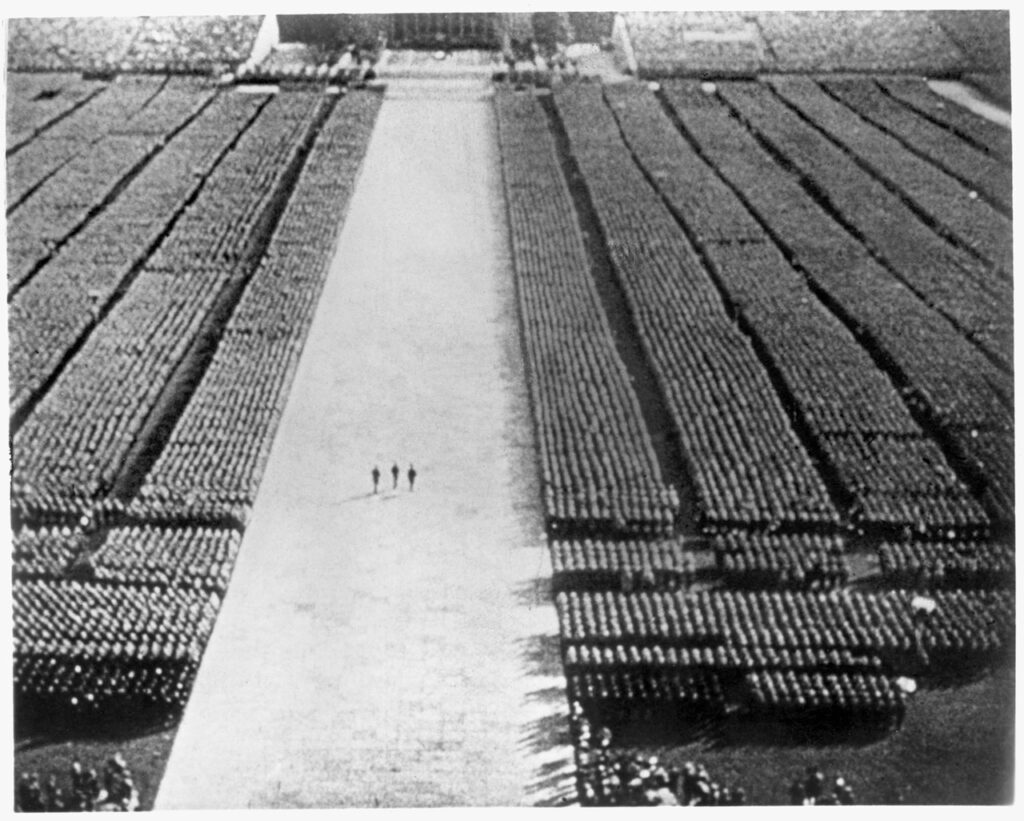Directed by Leni Riefenstahl
The list of reviled movies everyone should see is short. In fact, I would say there is only one reprehensible film that makes the list: Triumph of the Will, a film not only about Adolf Hitler, but one that helped elevate him to power and is therefore responsible for the Holocaust and World War II. No movie has a higher real-world body count than Leni Riefenstahl’s masterpiece.
And it is a masterpiece. It’s a documentary, but a carefully planned one, chronicling the arrival of a messiah from the skies. Observe the careful use of both verbal and visual language: the movie opens with the words:
20 years after the outbreak of the World War…
16 years after the start of German suffering…
19 months after the beginning of Germany’s rebirth, Adolf Hitler…
If that sounds like regnal timekeeping, it’s no accident. Compare to Luke 3:1:
Now in the fifteenth year of the reign of Tiberius Caesar, Pontius Pilate…
Or even Genesis 1: In the beginning, God…
The typeface is readily identifiable, a German Gothic. Adolf Hitler has come down from the heavens to save Germany. We see clouds, then an airplane, then the airplane’s shadow over Nuremberg, then the crowds waving flags awaiting the savior’s arrival. When he arrives, there is more Germanness—neat lines of tents, all alike, housing Hitler Youth. These young men wrestle shirtless and eat long strings of sausages. Then Wagner music plays. To see this is to take pride in being German.
The rally sets were built for cinema—towering structures combining Roman grandeur with Bauhaus sensibilities. The flags and banners look a hundred feet tall. What filmmaker ever had Albert Speer as a production designer? That would be like Frank Lloyd Wright building sets for Cecil B. DeMille. Elevators were built into the structures so Riefenstahl’s camera crew could get astonishing crane shots of the assembled throngs. Think of how one would shoot a Taylor Swift concert film. That’s what Riefenstahl did in 1935.
The speeches sometimes drag on, but there is canny editing, racing through montages of key lines overlaid with graphic text (again, in German gothic fonts). Hess, Himmler, Goebbels, and Todt all have their say before yielding the dais to the antichrist himself. Adolf Hitler speaks with a mix of fury and sentimental love for the crowd. He is all that stands between a proud but downtrodden German citizenry and them.
Who is them? The Allies of the Great War? The drafters of the Treaty of Versailles? The Jew? Now there is one word that is never uttered. Not once does Hitler offer his Final Solution or turn his wrath on the Elders of Zion. No, this is positivity writ large—Germany ascends, Germany prevails, Germany triumphs! (But never forget those opening words: World War… German suffering…)
Leni Riefenstahl was only 29 when she made Das Blaue Licht (The Blue Light), a beautiful movie starring a very beautiful Leni Riefenstahl. Hitler appreciated the atavistic film and commissioned her to make Triumph of the Will. There is no debating her talent—in this movie, she harnessed the power of cinema. She uses Eisensteinian editing to its maximum potential to create myth—a godlike fuhrer descends to Earth to redeem Germankind. She juxtaposes close-ups with sweeping panoramas—adoring Aryans in ordered ranks. This is Germany—clean, strong, free from the chaos and enervation of the Weimar era!
We are visual learners. Even without words, we see with aspiration. This was not the true Germany. This was the Germany of Hitler’s vision, one ordered and planned with beauty and a grand plan reflected so precisely in Riefenstahl’s film. Triumph of the Will was so effective, Frank Capra copied it in the Why We Fight series. George Lucas quoted the film twice: once in the medal ceremony that concludes Star Wars and again in Revenge of the Sith’s cleansing of the Jedi Temple. That one event celebrates the triumph of good and the other the triumph of evil matters not. Lucas saw in a piece of Nazi propaganda only grandeur and ceremony. Visually, it’s appropriate for both.
It’s amazing that today, effective propaganda can be so unsophisticated. What is a tweet or a meme compared to Triumph of the Will? (I suppose they succeed in sheer volume and repetition as opposed to craft.) Every peace and virtue-loving person should see this film and understand the power of the moving image. Then use that power for good—or at least avoid its thrall when used in the service of iniquity.

